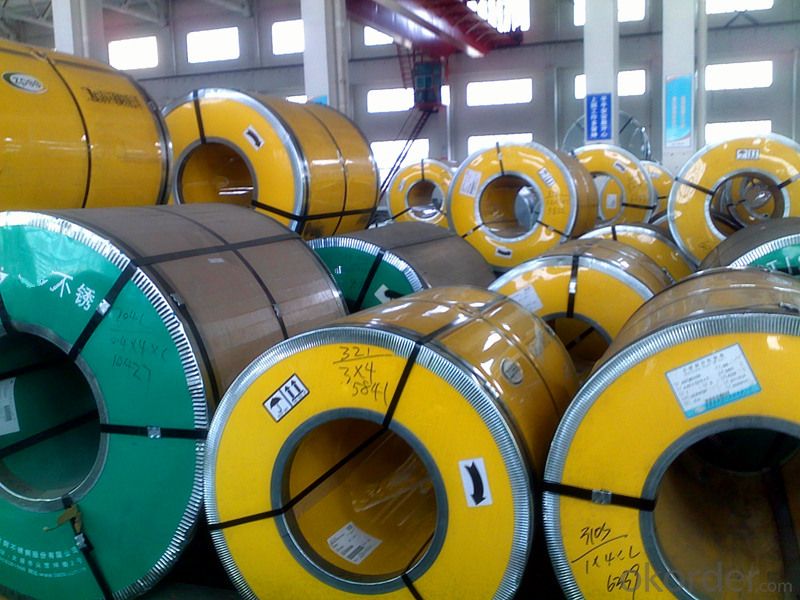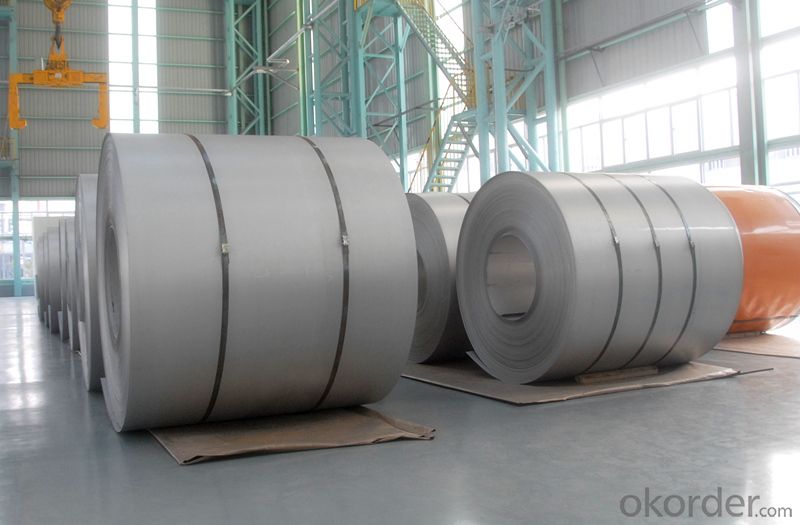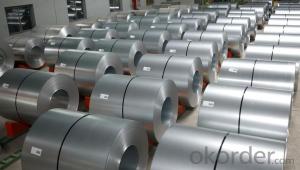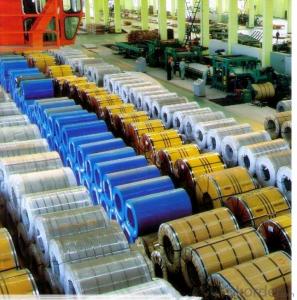Stainless Steel Coil Cold Rolled 201 Surface No.4 with Good Quality
- Loading Port:
- China main port
- Payment Terms:
- TT OR LC
- Min Order Qty:
- 400 m.t.
- Supply Capability:
- 20000 m.t./month
OKorder Service Pledge
OKorder Financial Service
You Might Also Like
1. Structure of Stainless Steel Coil Cold Rolled 201 Descriptions
Stainless Steel 201 is a new kind of Austenite stainless steel by used Mn, N replace Ni. The steel has good corrosion resistance and hot / cold processing performance, instead of 304 stainless steel products for used in the not high of corrosive environment, such as indoor, inland city outdoor etc.
2. Main Features of the Stainless Steel Coil Cold Rolled 201
Product name: Stainless Steel Coil Cold Rolled 201
Thickness: 0.2mm to 1.5mm
Technical: Cold Rolled
Width: 10mm to 1240mm
Type: 200 Series
Length: As customer's requested
Standard: JIS, SUS, AISI, ASTM
Grade: 201-J1, 201-J4, AISI201, AISI202…
Finish: BA, 2B, 8K, NO.3, NO.4, HL…
MOQ: 25 Metric Tons
Hardness: Low Hard(190 HV Max); Half Hard(240-280HV); Full Hard(42-60 HRC)
Ship Term: FOB any port, China or CFR Destination port
Delivery Time: 15 to 20 day after the receive the deposit or 100%LC
Payment Terms: TT 30% for deposit, Balance against the copy of B/L, or 100%LC
Packaging: By wooden pallet, wooden case or according to customer's request
3. Stainless Steel Coil Cold Rolled 201 Images


4. Stainless Steel Coil Cold Rolled 201 Specifications
Mechanical Property Contrast | YS (Mpa) | TS (Mpa) | EL(%) | HV | REMARK |
Stainless Steel 201 | 426 | 880 | 52 | 224 | 1.0t |
Stainless Steel 304 | 285 | 710 | 58 | 165 | 1.0t |
Stainless Steel 200 Series Chemicals Contrast (wt. %) | ||||||||
Chemicals | C | Si | Mn | Cr | Ni | N | Other | |
205 | 0.12-0.25 | ≤0.75 | 14.0-15.0 | 16.5-18.0 | 1.0-1.75 | 0.32-0.4 | ||
JIS, | 201 | ≤0.15 | ≤1.0 | 5.5-7.5 | 16.0-18.0 | 3.5-5.5 | ≤0.25 | - |
201L | ≤0.03 | ≤0.75 | 5.5-7.5 | 16.0-18.0 | 3.5-5.5 | ≤0.25 | - | |
202 | ≤0.15 | ≤1.0 | 7.5-10.0 | 17.0-19.0 | 4.0-6.0 | ≤0.25 | - | |
201LN | ≤0.03 | ≤0.75 | 6.4-7.5 | 16.0-17.5 | 4.0-5.5 | 0.1-0.25 | Cu≤1.0 | |
India | 201-J1 | ≤0.08 | ≤0.75 | 7.0-8.0 | 15.0-17.0 | 4.0-5.0 | ≤0.1 | Cu≤1.5 |
201-J3 | ≤0.08 | ≤0.75 | 9.0-10.5 | 14.0-16.0 | 2.0-3.0 | ≤0.15 | Cu≤2.0 | |
201-J4 | ≤0.10 | ≤0.75 | 8.5-10.0 | 15.0-16.0 | ≤1.2 | ≤0.2 | Cu≤2.0 | |
America | 204 | ≤0.03 | ≤1.0 | 7.0-9.0 | 15.0-17.0 | 1.5-3.0 | 0.15-0.3 | (Cu) |
H400 | ≤0.10 | ≤1.0 | 6.0-9.0 | 17.0-19.5 | ≤3.5 | ≤0.3 | - | |
Japan | YUS130S | 0.09 | 0.5 | 11.0 | 18.0 | 6.5 | 0.35 | - |
NTK S-4 | 0.17 | 0.43 | 14.7 | 17.7 | 1.3 | 0.35 | - | |
NM15M | 0.08 | 0.8 | 14.5 | 17.0 | 4.3 | 0.33 | - | |
Europe America | 219 | ≤0.04 | ≤0.75 | 8.0-10.0 | 19.0-21.5 | 5.5-7.5 | 0.15-0.4 | - |
Cromanite | ≤0.08 | ≤1.0 | 9.5-11.0 | 18.0-20.0 | ≤1.0 | 0.4-0.6 | - | |
201 Surface | Characteristic and Application of Stainless Steel Coil Cold Rolled 201 |
2B | The surface brightness and flatness of 2B is better than 2D then through a special surface treatment to improve its mechanical properties,2B could nearly Satisfy comprehensive uses |
No.4 | Polished with abrasive belt of grit#150#180, have better brightness with discontinuous coarse stria, but thinner than NO.3, are used as bathtub buildings inner and electrical appliances kitchen utensils and food processing. |
BA | Cold rolled, bright annealed and skin-passed, the product have excellent brightness like mirror kitchen apparatus, etc. |
8K | The product have excellent brightness and prefer bright can be the mirror. |
5. FAQ of Stainless Steel Coil Cold Rolled 201
Q: Can you provide mill test certificate?
A: Yes! Mill test certificate for both hot rolled raw material coils and cold rolled coils are available.
Q: How to get a sample?
A: Free samples are available for your checking and testing. And to get free samples, please send us your detailed receiving address (including post code) and your DHL/FEDEX/UPS account for collecting samples, courier cost will be paid in your side.
Q: How about your company?
A world class manufacturer & supplier of castings forging in stainless steel, is one of the large-scale professional investment casting production bases in China, consisting of both casting foundry forging and machining factory. Annually more than 90000 tons Precision casting and forging parts are exported to markets in Europe, America and Japan. OEM casting and forging service are available, all according to customer’s requirements.
Q: How to guarantee the quality of the products?
A: We have established the international advanced quality management system,every link from raw material to final product we have strict quality test; We resolutely put an end to unqualified products flowing into the market. At the same time, we will provide necessary follow-up service assurance.
Q: How is the packaging and delivery?
A: Standard export packing (Coil: waterproof paper + protective steel ring; Circle: wooden box), or as your requirement and the delivery term is based on the project.
- Q:Can stainless steel strips be used in the production of automotive exhaust systems?
- Yes, stainless steel strips can be used in the production of automotive exhaust systems. Stainless steel strips are often preferred for exhaust systems due to their high temperature resistance, corrosion resistance, and durability. They can withstand the extreme heat and corrosive gases generated by the engine, making them a suitable choice for this application.
- Q:Can stainless steel strips be used in automotive industries?
- Stainless steel strips have the ability to be utilized within the automotive sector. The properties of stainless steel, including its impressive resistance to corrosion, high strength, and durability, establish it as an appropriate material for a variety of applications in the automotive industry. Automotive components, such as exhaust systems, trim, body panels, brackets, and reinforcements, are frequently manufactured using stainless steel strips. These strips possess the capability to withstand the harsh conditions commonly found in automotive environments due to their resistance to heat, chemicals, and wear. In addition, the ease with which stainless steel strips can be shaped, welded, and fabricated allows for flexibility in design and efficient production. As a result, stainless steel strips have become a dependable and widely preferred choice in the automotive industry.
- Q:Can stainless steel strips be used in the automotive parts industry?
- Yes, stainless steel strips can definitely be used in the automotive parts industry. Stainless steel is a versatile and durable material that offers a wide range of benefits for automotive applications. It is corrosion-resistant, which is crucial in an industry where exposure to various weather conditions and road salts can cause rust and deterioration. Stainless steel strips also have high strength and excellent impact resistance, making them suitable for structural components like chassis and body panels. Additionally, stainless steel strips can be easily formed, welded, and machined, allowing for customization and integration into different automotive parts and assemblies. Due to these advantageous properties, stainless steel strips are commonly used in the production of exhaust systems, trim, brackets, fasteners, and other automotive components.
- Q:Can stainless steel strips be used in heat-resistant furnaces?
- Yes, stainless steel strips can be used in heat-resistant furnaces. Stainless steel has excellent heat resistance properties, making it a suitable material for use in high-temperature environments such as heat-resistant furnaces. It can withstand high levels of heat without warping or losing its structural integrity, making it a reliable choice for such applications.
- Q:Can stainless steel strips be used in defense applications?
- Indeed, defense applications can make use of stainless steel strips. Renowned for its strength, durability, and resistance to corrosion, stainless steel proves to be an ideal material for various defense-related purposes. Its exceptional qualities enable the manufacturing of military vehicle components, including armor plating, brackets, and reinforcements, as it can endure high impact and provide protection against ballistic threats. In addition, stainless steel strips find utility in fabricating weapon systems, ammunition, and equipment employed by defense forces. The material's ability to resist heat and corrosion renders it suitable for applications such as missile casings and jet engine components. Consequently, stainless steel strips are extensively employed in defense applications due to their superior mechanical properties and reliability.
- Q:What are the common uses of stainless steel strips in the aerospace fastener industry?
- Stainless steel strips are commonly used in the aerospace fastener industry for various purposes such as manufacturing aircraft components, assembling structures, and securing parts together due to their high strength, corrosion resistance, and durability. These strips are utilized in fasteners like bolts, nuts, screws, and rivets, ensuring the integrity and reliability of aircraft structures even in extreme conditions.
- Q:How does the thermal conductivity of 111 stainless steel strips compare to other materials?
- The thermal conductivity of 111 stainless steel strips is generally higher compared to many other materials, making it an efficient conductor of heat.
- Q:How do stainless steel strips resist stress corrosion cracking in chloride environments?
- Stainless steel strips are highly resistant to stress corrosion cracking in chloride environments due to their inherent properties and specific alloy composition. The primary factors that contribute to this resistance include the presence of chromium, molybdenum, and nickel in the stainless steel alloy. Chromium is the main component responsible for the corrosion resistance of stainless steel. When exposed to chloride ions in the environment, a passive oxide layer of chromium oxide forms on the surface of the stainless steel strips. This oxide layer acts as a protective barrier, preventing the penetration of chloride ions and reducing the likelihood of stress corrosion cracking. Molybdenum is another crucial element in stainless steel alloys that enhances their resistance to stress corrosion cracking in chloride environments. It provides additional protection by increasing the material's resistance to pitting and crevice corrosion, which can be precursors to stress corrosion cracking. The presence of molybdenum also improves the overall strength and durability of the stainless steel strips. Nickel is an alloying element that further enhances the resistance of stainless steel strips to stress corrosion cracking. It increases the material's ability to withstand the corrosive effects of chloride ions, thereby minimizing the risk of crack initiation and propagation. In addition to these alloying elements, the specific composition and microstructure of the stainless steel strips play a crucial role in their resistance to stress corrosion cracking. The selection of an appropriate stainless steel grade, such as 316 or 904L, with a higher content of chromium, molybdenum, and nickel, ensures optimal resistance to chloride-induced corrosion. Furthermore, proper fabrication processes and surface treatments, such as passivation, can help enhance the corrosion resistance of stainless steel strips in chloride environments. Passivation involves the removal of iron contaminants from the surface and the formation of a more uniform and protective chromium oxide layer, further reducing the risk of stress corrosion cracking. Overall, stainless steel strips resist stress corrosion cracking in chloride environments due to the synergistic effects of chromium, molybdenum, and nickel, as well as their specific alloy composition, microstructure, and surface treatments. These factors collectively contribute to the exceptional corrosion resistance of stainless steel, making it a preferred choice for various industries, including marine, chemical, and oil and gas.
- Q:What is a stainless steel strip?
- A stainless steel strip is a thin, flat piece of stainless steel material that is typically manufactured in a continuous roll or coil form. It is commonly used in various industries due to its excellent corrosion resistance, strength, and durability. The strip is produced by cold rolling stainless steel sheets or coils to a precise thickness, resulting in a smooth and uniform surface. It can be further processed or fabricated into different forms, such as sheets, plates, or even precision components. Stainless steel strips find extensive applications in automotive, aerospace, construction, electronics, and many other sectors where high-quality and reliable materials are required.
- Q:Are stainless steel strips suitable for decorative trim?
- Stainless steel strips are indeed appropriate for decorative trim. This versatile material boasts a sleek and modern aesthetic, which explains its popularity in decorative applications. Its polished and reflective surface adds a touch of sophistication and elegance to any space. Moreover, stainless steel strips are known for their durability, corrosion resistance, and easy maintenance, making them perfect for low-maintenance areas. They can be utilized in various settings such as kitchens, bathrooms, and commercial spaces to create a contemporary and stylish atmosphere. Furthermore, stainless steel strips offer endless design possibilities as they can be easily customized and fabricated into different shapes and sizes. In conclusion, stainless steel strips are an excellent choice for enhancing the decorative aspect of any interior or exterior space.
1. Manufacturer Overview |
|
|---|---|
| Location | |
| Year Established | |
| Annual Output Value | |
| Main Markets | |
| Company Certifications | |
2. Manufacturer Certificates |
|
|---|---|
| a) Certification Name | |
| Range | |
| Reference | |
| Validity Period | |
3. Manufacturer Capability |
|
|---|---|
| a)Trade Capacity | |
| Nearest Port | |
| Export Percentage | |
| No.of Employees in Trade Department | |
| Language Spoken: | |
| b)Factory Information | |
| Factory Size: | |
| No. of Production Lines | |
| Contract Manufacturing | |
| Product Price Range | |
Send your message to us
Stainless Steel Coil Cold Rolled 201 Surface No.4 with Good Quality
- Loading Port:
- China main port
- Payment Terms:
- TT OR LC
- Min Order Qty:
- 400 m.t.
- Supply Capability:
- 20000 m.t./month
OKorder Service Pledge
OKorder Financial Service
Similar products
New products
Hot products
Related keywords




























